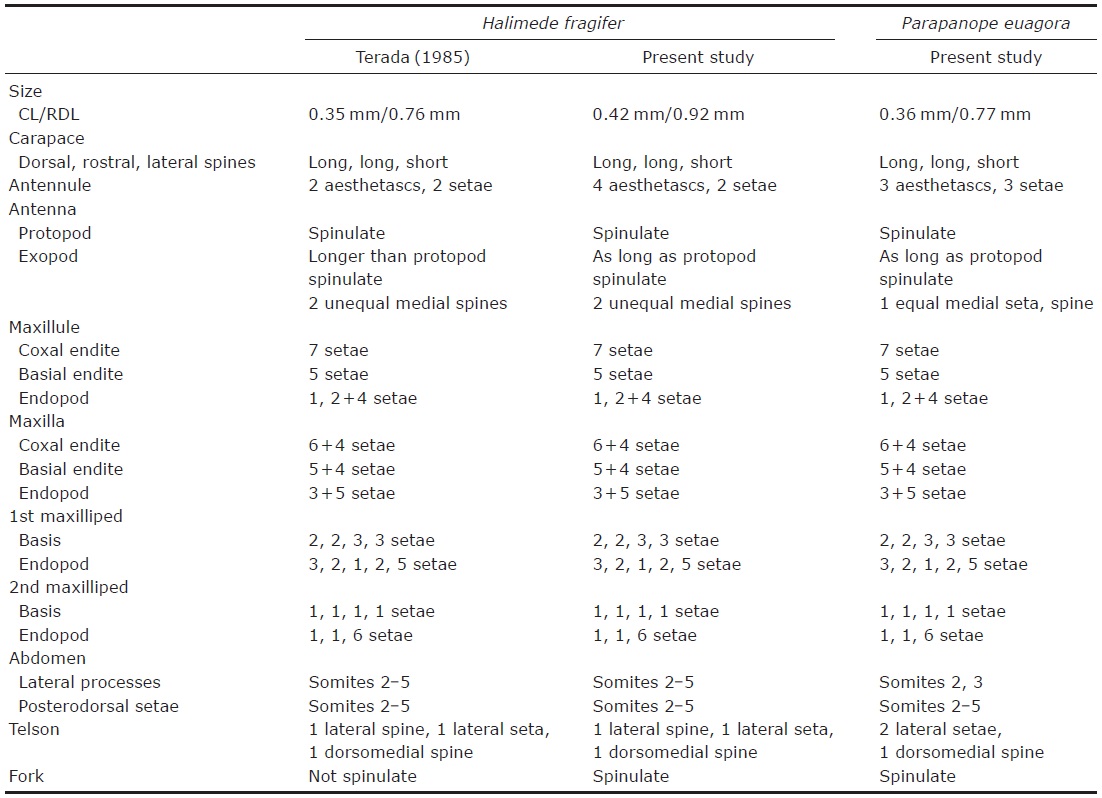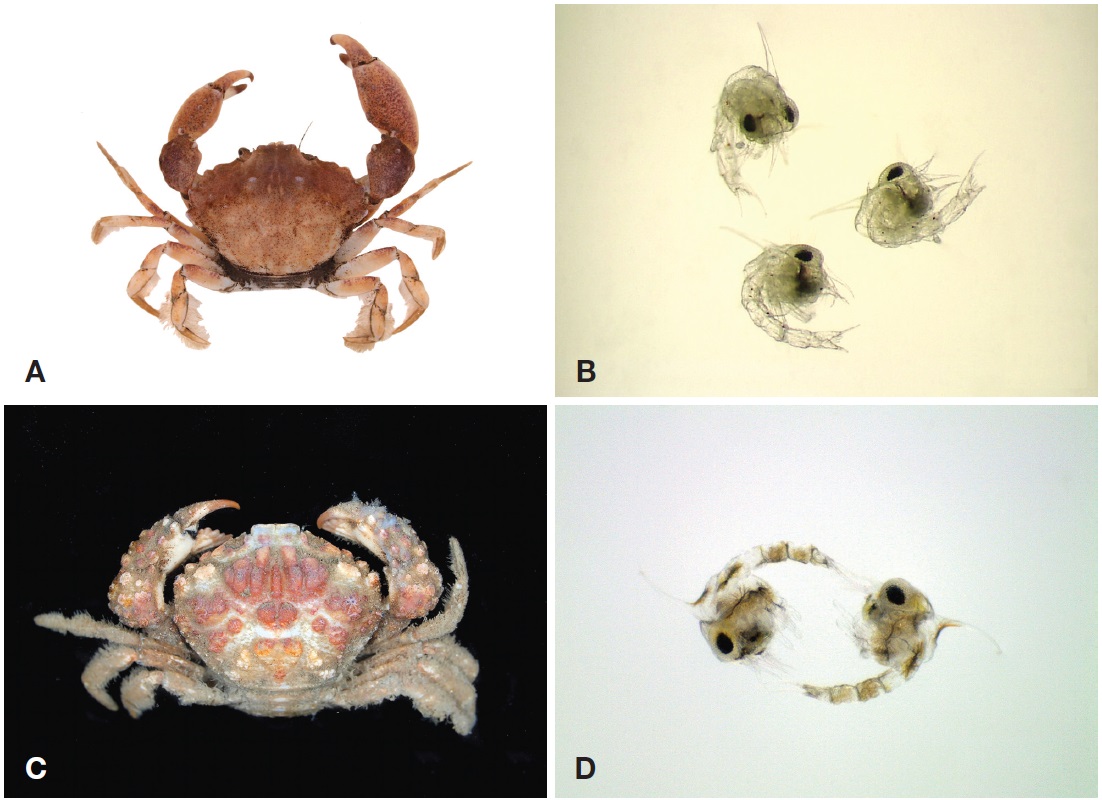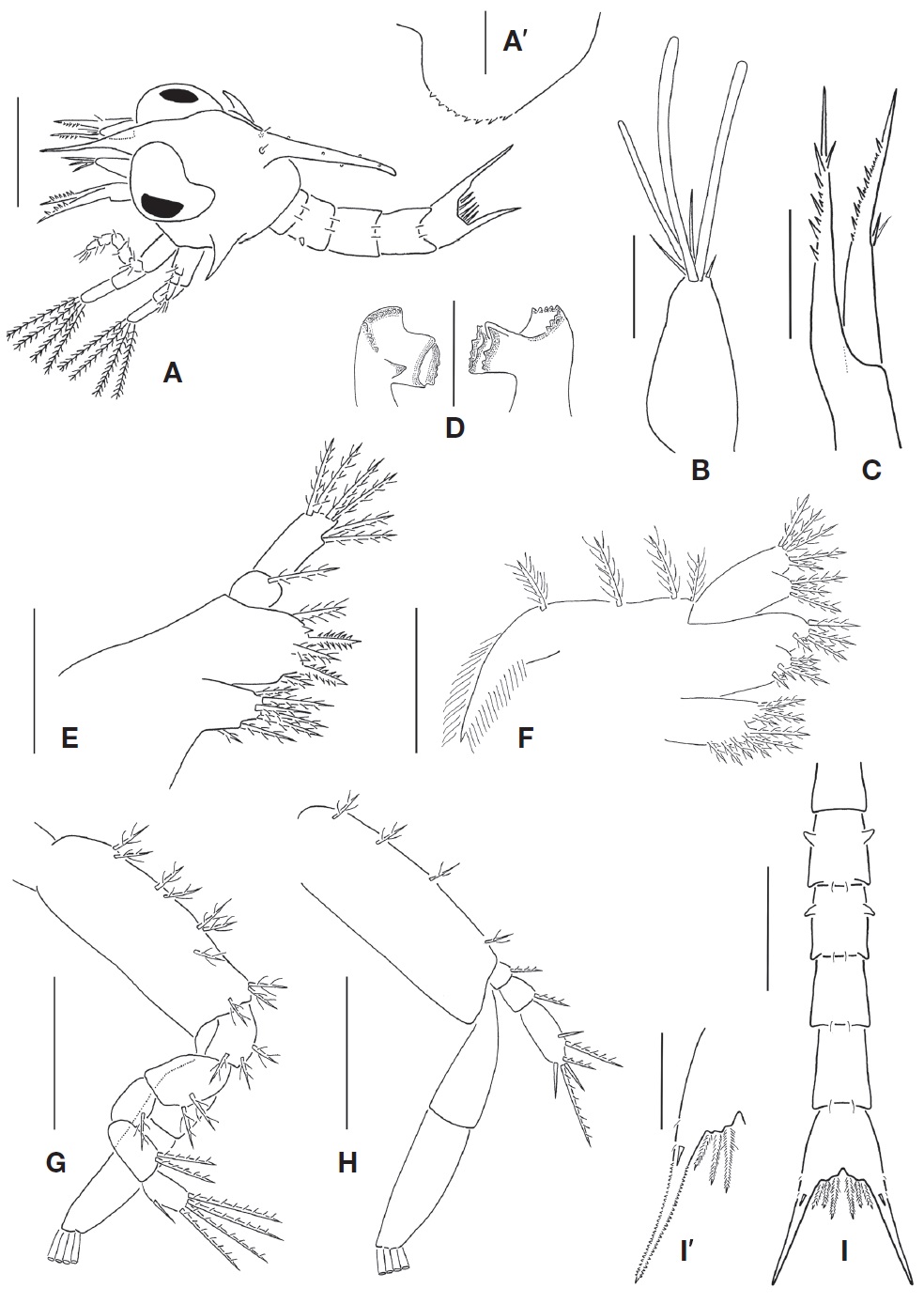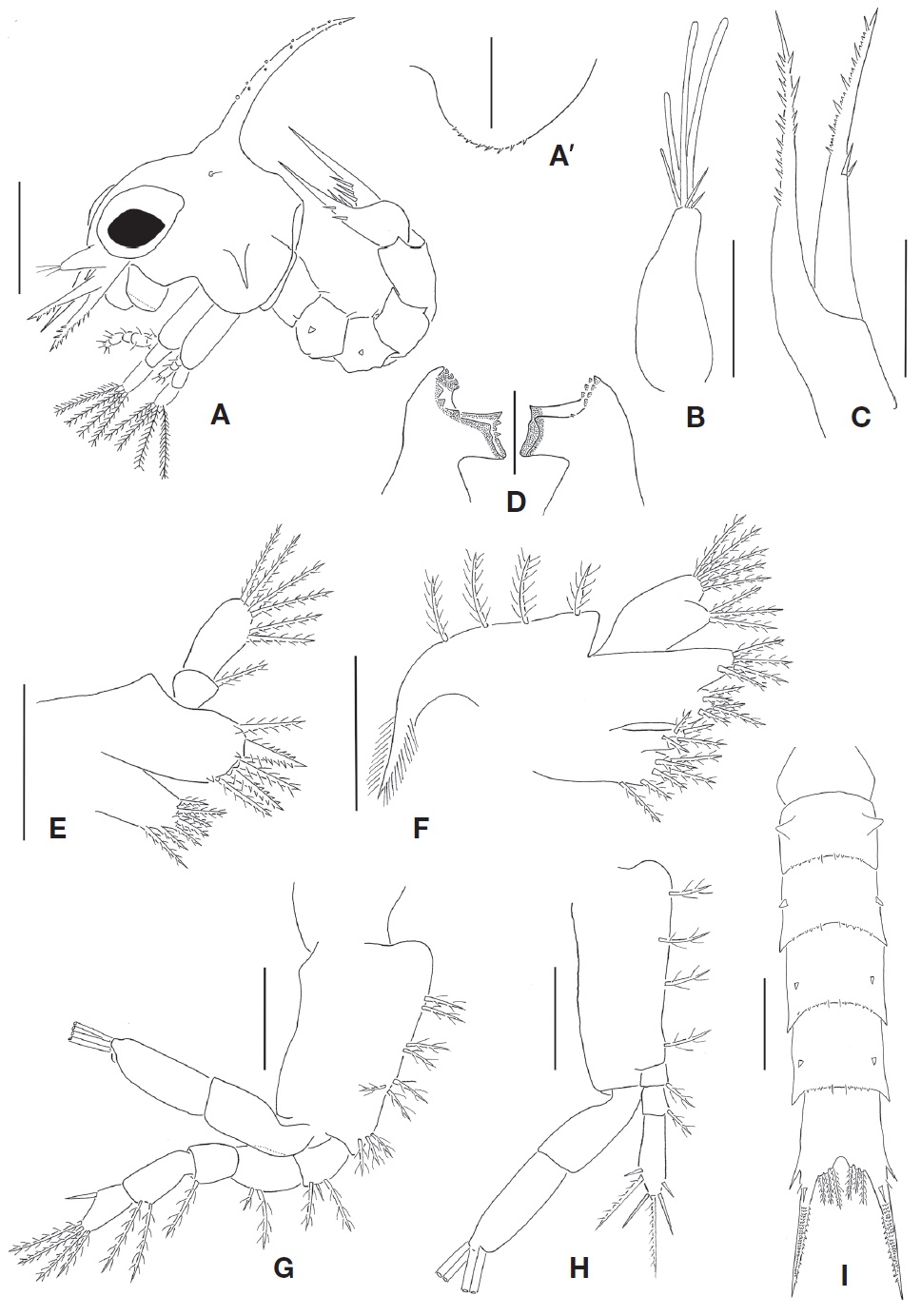



The crabs of the Pilumnoidea are recognized by the following characteristics of all male abdominal somites freely articulating, a long and slender gonopod 1, a very short and sigmoidal gonopod 2, and a penis which protrudes from the condyle of the fifth ambulatory coxa (Ng et al., 2008). At present, over 390 species of three families (Galenidae, Pilumnidae, and Tanaochelidae) have been recorded in the world. Over 380 species of the Pilumnidae exist in the world, and 15 species are known from Korean waters (Table 1). In the Galenidae, 12 species are reported in the world (Ng et al., 2008). Among them, only two species,

List of species of the superfamily Pilumnoidea from Korean waters and its known larval stages
In the Pilumnoidea, larval descriptions of Pilumnidae are known for nine species belonging to six genera from Korea and adjacent waters (Table 1). The larval description of Galenidae is only available for the first and second zoeal stages of
Ovigerous crabs were collected in the intertidal region in Jindo-gun, Jeolanam-do, southern Korea on 26 Jul 2012 for
>
Parapanope euagora De Man, 1895 (
First zoea (
Size: CL 0.36±0.05 mm; RDL 0.77±0.05 mm.
Chromatophores (Fig. 1B): black chromatophores which occurring behind eyes and on abdominal somites 1-4 ventrally.
Carapace (Figs. 1B, 2A, A′): dorsal spine with few minute tubercles, less than CL, slightly longer than rostral spine; rostral spine slightly longer than antennal protopod; lateral spines present, half length of rostral spine; 1 pair of posterodorsal setae present; each ventral margin with spinules; eyes sessile.
Antennule (Fig. 2B): uniramous; endopod absent; exopod with 2 long, stout aesthetascs, 1 shorter, thinner aesthetasc, 3 unequal simple setae, all terminal.
Antenna (Fig. 2C): biramous; endopod bud absent; protopod with 2 rows of spinules on distal half; exopod spinulate on distal half, with 2 equal setae medially, tip reaching tip of protopod.
Mandibles (Fig. 2D): asymmetrical; right molar with 4 teeth, left molar with 3 teeth, confluent with incisor process; palp absent.
Maxillule (Fig. 2E): coxal endite with 7 setae; basial endite with 5 setae and 2 teeth; endopod 2-segmented, proximal segment with 1 seta, distal segment with 6 (2 subterminal, 4 terminal) setae; exopod seta and epipod absent.
Maxilla (Fig. 2F): coxal endite bilobed, with 6+4 setae; basial endite bilobed, with 5+4 setae, 1 tooth; endopod bilobed, with 3+5 setae; exopod (scaphognathite) margin with 4 plumose setae, 1 distal process.
First maxilliped (Fig. 2G): coxa without seta; basis with 10 setae, arranged 2+2+3+3; endopod 5-segmented, with 3, 2, 1, 2, 5 (1 subterminal, 4 terminal) setae; exopod 2-segmented, distal segment with 4 long terminal plumose natatory setae.
Second maxilliped (Fig. 2H): coxa without seta; basis with 4 setae, arranged 1+1+1+1; endopod 3-segmented, with 1, 1, 6 (2 subterminal, 4 terminal) setae; exopod 2-segmented, distal segment with 4 long terminal plumose natatory setae.
Abdomen (Fig. 2I): five somites; somite 2 with 1 pair of lateral processes directed anteriorly; somite 3 with 1 pair of lateral processes directed posteriorly; somites 2-5 each with 1 pair of posterodorsal setae; pleopod absent.
Telson (Fig. 2I, I′): each fork extremely long, spinulated laterally, with 2 lateral setae, 1 dorsomedial spine; posterior margin with 3 pairs of setae.
>
Halimede fragifer (De Haan 1835) (
First zoea (
Size: CL 0.42±0.03 mm; RDL 0.92±0.02 mm.
Chromatophores (Fig. 1D): yellowish brown chromatophores which occurring behind eyes, on basis of dorsal spine posteriorly, on basis of each maxilliped, on abdominal somites 1, 2 medially, margins of abdominal somites 4, 5 posteriorly, telson ventrally.
Carapace (Figs. 1D, 3A, A′): dorsal spine with few minute tubercles, slightly less than CL, twice longer than rostral spine; rostral spine slightly shorter than antennal protopod; lateral spines present, half length of rostral spine; 1 pair of posterodorsal setae present; each ventral margin with spinules; eyes sessile.
Antennule (Fig. 3B): uniramous; endopod absent; exopod with 2 long, stout aesthetascs, 2 shorter, thinner aesthetascs, 2 unequal simple setae, all terminal.
Antenna (Fig. 3C): biramous; endopod bud absent; protopod with 2 rows of spinules on distal half; exopod spinulate on distal half, with 2 unequal spines medially, tip reaching tip of protopod.
Mandibles (Fig. 3D): asymmetrical; right molar with 3 teeth, left molar with 4 teeth, confluent with incisor process; palp absent.
Maxillule (Fig. 3E): coxal endite with 7 setae; basial endite with 5 setae and 3 teeth; endopod 2-segmented, proximal segment with 1 seta, distal segment with 6 (2 subterminal, 4 terminal) setae; exopod seta and epipod absent.
Maxilla (Fig. 3F): coxal endite bilobed, with 6+4 setae; basial endite bilobed, with 5+4 setae, 1 tooth; endopod bilobed, with 3+5 setae; exopod (scaphognathite) margin with 4 plumose setae, 1 distal process.
First maxilliped (Fig. 3G): coxa without seta; basis with 10 setae, arranged 2+2+3+3; endopod 5-segmented, with 3, 2, 1, 2, 5 (1 subterminal, 4 terminal) setae; exopod 2-segmented, distal segment with 4 long terminal plumose natatory setae.
Second maxilliped (Fig. 3H): coxa without seta; basis with 4 setae, arranged 1+1+1+1; endopod 3-segmented, with 1, 1, 6 (3 subterminal, 3 terminal) setae; exopod 2-segmented, distal segment with 4 long terminal plumose natatory setae.
Abdomen (Fig. 3I): five somites; somite 2 with 1 pair of lateral processes directed laterally; somites 3-5 each with 1 pair of lateral processes directed posteriorly; somites 2-5 each with 1 pair of posterodorsal setae and 8 denticles on posterior margin; pleopod absent.
Telson (Fig. 3I): each fork long, covered with spinules, with 1 stout lateral spine, 1 minute lateral seta and 1 stout dorsomedial spine; posterior margin with 3 pairs of setae.
The first zoeal stage of
Terada (1985) described the first and second zoeal stages of

Comparison of the first zoeal characteristics between Halimede fragifer and Parapanope euagora of the family Galenidae
The first zoeal stage of
Ko and Lee (2012) summarized the morphological characteristics of the first zoeas of Pilumnoidea as follows: long antennal exopod and protopod wih subequal length, and the antennal exopod with two medial spines; the endopods of the maxillule and maxilla each have 1, 2+4 setae, and 3+5 setae, respectively; and the fork of telson has one seta and one spine laterally. The first zoeal stage of
[Table 3.] Comparison of the first zoeal characteristics for the Pilumnoidea from Korean waters

Comparison of the first zoeal characteristics for the Pilumnoidea from Korean waters





